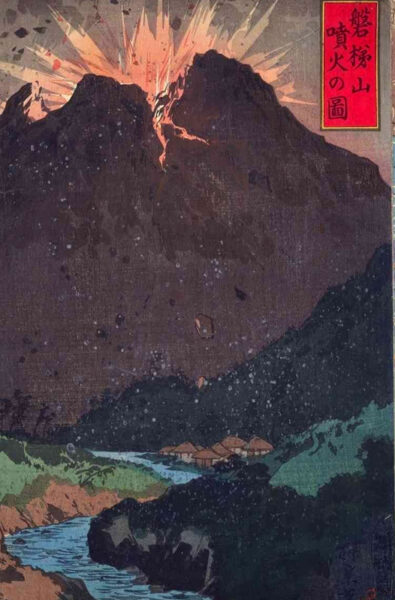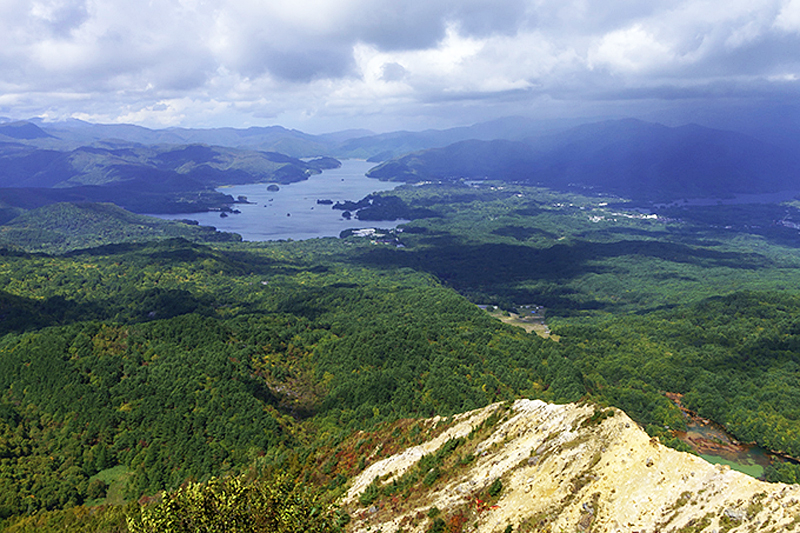
Urabandai is attractive for its beautiful scenery created by the powerful volcanoes and the beautiful lakes and small lakes [Fukushima Prefecture]
table of contents
- 1 Omotebandai and Urabandai were formed by an eruption during the Meiji period
- 2 Despite its appearance, Mount Bandai is a relatively tranquil volcano
- 3 The collapse of the mountain in the Meiji period created many large and small lakes, including Lake Hibara and Lake Goshikinuma
- 3.1 "Dounuma" where the scars of a mountain collapse remain vividly
- 3.2 Lake Hibara, the largest lake in Urabandai and a tourist hub
- 3.3 Lake Onogawa, famous for smelt and bass fishing
- 3.4 Lake Akimoto: A quiet lake with untouched nature
- 3.5 Lake Sohara is a small lake with a circumference of 3.5km, perfect for a stroll
- 3.6 The beautiful and mysterious "Goshikinuma" swamp, where various colors and expressions appear
- 3.7 Oguni-numa and Oguni-numa Wetlands, home to a natural monument plant community
Mount Bandai Volcano (located in Inawashiro Town, Bandai Town, and Kitashiobara Village in Fukushima Prefecture) is one of Japan's most famous active volcanoes, consisting of three peaks: Mount Bandai (Obandai, 1,816m above sea level), Kushigamine (1,636m), and Akahaniyama (1,430m)
Omotebandai and Urabandai were formed by an eruption during the Meiji period

Mt. Bandai originally had a beautiful shape similar to Mt. Fuji, but at around 7:45 a.m. on July 15, 1888 (Meiji 21), it exploded with a loud noise, erupting nearly 20 times in a short period of time and destroying most of Kobandaiyama. When you look at Mt. Bandai from the north, the collapsed part appears as a large hollow, vividly demonstrating the terrifying power of earth's activity

On the other hand, when viewed from the south side, where Lake Inawashiro is located, the collapsed parts are not visible, and the mountain appears to have a beautiful conical ridgeline. This gentle view is called Omotebandai, while the rugged view on the other side is called Urabandai
Despite its appearance, Mount Bandai is a relatively tranquil volcano
Mount Bandai is often thought of as an active volcano because of the large-scale landslides it has caused, but it has only had two full-scale eruptions in recorded history, in 806 and 1888, and those were medium-sized eruptions (according to data from the Japan Meteorological Agency). In 1888, multiple steam explosions occurred in a short period of time, causing the mountain to collapse, but it did not scatter large amounts of volcanic rocks or volcanic ash over a wide area like Mount Fuji or Mount Asama. Nevertheless, there have been multiple volcanic earthquakes since 1888. Most recently, the number of volcanic earthquakes has increased significantly since November 2022, and the Japan Meteorological Agency has issued a warning that extreme caution is required

Looking at Mt. Bandai from the perspective of Earth's history, it is believed that a major eruption occurred 30,000 to 50,000 years ago, accompanied by the collapse of the mountain's edifice, which created Lake Inawashiro. Recent research has led to the theory that the summit, which was once higher than Mt. Fuji, collapsed during the eruption, causing a debris flow that dammed the river at the base of the mountain, forming Lake Inawashiro. A new volcano was then born in the caldera (crater floor) that formed at the summit, and this volcano grew to become Mt. Bandai (Obandai), also known as Aizu Fuji today
The collapse of the mountain in the Meiji period created many large and small lakes, including Lake Hibara and Lake Goshikinuma

The 1888 eruption caused collapsed soil to block the river, creating many lakes and marshes in Urabandai. It is said that there are more than 300 of them, ranging from large lakes such as Lake Hibarako and Lake Onogawako to areas like Goshikinuma, where small marshes are scattered across a narrow area
"Dounuma" where the scars of a mountain collapse remain vividly

Akanuma Pond is a place where you can see the remains of the 1888 mountain collapse up close. It is a crater lake formed when water accumulated in a crater, and is located at an altitude of 1,120m. Akanuma Pond is filled with clear, highly acidic water containing metal ions such as iron, aluminum, and manganese, but it was named "Akanuma" because the iron-rich mud that has accumulated at the bottom, which has turned red, can be seen through the water
Steam rises from the reddish-brown rocks around the swamp, and rugged cliffs with vivid traces of collapses loom close behind. The scenery really makes you realize that Mt. Bandai is an active volcano
The route to Donuma is about an hour's hike one way, and proper equipment is required
Lake Hibara, the largest lake in Urabandai and a tourist hub

Lake Hibara is a lake formed when a river was dammed up by an eruption in 1888. With an elevation of approximately 822m, a circumference of approximately 31km, and a maximum depth of approximately 31m, it is the largest lake in Urabandai and the largest volcanic dammed lake in Japan. Located in the center of Urabandai, it is easily accessible and serves as a base for sightseeing in Urabandai
Hibaru was originally a post town on the old Yonezawa Kaido road, and prospered from the Sengoku period through to the Edo period. However, the town was submerged by an eruption in 1888. Traces of this can be seen in the approach and torii gate of Oyamazumi Shrine, which emerge from the bottom of the lake during droughts
Lake Onogawa, famous for smelt and bass fishing

Lake Onogawa is about 797 meters above sea level and has a circumference of about 10 km. Its source is a large waterfall called Onogawa Fudo Falls, which has a drop of about 25 meters and a width of about 15 meters. Water overflowing from Lake Hibara also flows into Lake Onogawa
Onogawa Fudo Falls is a beautiful waterfall that flows down into the deep greenery, but in the midst of the snowy landscape, it is especially spectacular in the harsh winter. Lake Onogawa is a nutrient-rich lake, and is a mecca for smelt and bass fishing, attracting many anglers
Lake Akimoto: A quiet lake with untouched nature

Lake Akimoto is the second largest lake in Urabandai, located east of Lake Onogawa, at an elevation of approximately 736m and with a circumference of approximately 20km. It was formed when the Nagase River, which flows out of Lake Onogawa, was dammed up during an eruption in 1888
Lake Akimoto is located quite far from the tourist center of Lake Hibara, so it does not attract many tourists, but from late January to February when the lake surface freezes over, ice fishing for smelt is extremely popular among fishing enthusiasts
Lake Sohara is a small lake with a circumference of 3.5km, perfect for a stroll
Lake Sohara is a small lake with a circumference of about 3.5km, located about 150m east of Lake Hibara. It is the fourth largest lake in Urabandai, and at an altitude of about 830m, it is slightly higher than Lake Hibara. The water is a slightly murky brown, but this is due to the leaves of the surrounding broad-leaved trees having fallen and decomposed. There is an abundance of plankton and aquatic plants, and many wild birds fly in, and there are walking paths around the lake
The beautiful and mysterious "Goshikinuma" swamp, where various colors and expressions appear
The 1888 eruption of Mount Bandai created several large dammed lakes, such as Lake Hibara and Lake Akimoto, but also hundreds of small pond-like marshes in the area. There are more than 30 such marshes clustered together on the west shore of Lake Hibara. The water in each of these marshes has a slightly different hue, and they are known as the "Goshikinuma Lakes and Marshes."
The water of the Goshikinuma Lake Group is connected to the underground water of Donuma, which contains a lot of hydrogen sulfide (sulfate ions). When the underground water comes to the surface, the two mix together, causing the water quality to change subtly, resulting in each lake appearing a different color
The Goshikinuma Lakes and Marshes are located in a relatively flat area at an elevation of 780m to 815m, and are connected by a walking trail. The Goshikinuma Nature Trail is approximately 4km long and can be safely walked by families during the green season (snowshoes and other equipment are required in winter due to the snow)
The Goshikinuma Nature Trail has two entrances, one on the Hibara Lake side and one on the Bishamon Lake side, and each has an information center, bus stop, and parking lot
Among the Goshikinuma Lakes and Ponds, the most famous are Aonuma, Rurinuma, and Bishamonnuma
Aonuma

Aonuma is located about 1 km from the entrance to the Goshikinuma Nature Trail on the shore of Lake Hibara, and can be reached in about 15 minutes. The water is clear, but on sunny days it turns a beautiful, clear blue
Ruri Swamp

Ruri Numa is located very close to Aonuma and is a shining blue. Its color is slightly different from Aonuma's and is very striking
Bishamon Pond

Bishamon Lake is the largest of the Goshikinuma Lake Group. From the entrance on the Bishamon Lake side, it's about 400m to the observation deck. The water is a slightly murky blue-green, and it's a scenic lake with a view of Mount Bandai directly ahead
Goshikinuma Nature Trail<Information>
- Facility name: Goshikinuma Nature Trail
- Total length: approx. 4km
- Travel time: 1 hour 10 minutes to 1 hour 30 minutes one way
- Difficulty: Beginner
Entrance to Urabandai Plateau (Lake Hibara side)
- Information Center: Urabandai Products Center
- Phone number: 0241-32-3751
Goshikinuma entrance (Bishamonuma side)
- Information Center: Urabandai Visitor Center
- Phone number: 0241-32-2850
Oguni-numa and Oguni-numa Wetlands, home to a natural monument plant community

Oguninuma is a crater lake on Mt. Nekomagadake (1,404m), which towers to the west of Mt. Bandai, and is said to have been created by volcanic activity about 500,000 years ago
Oguni-numa is located at an elevation of over 1,000 meters, and the surrounding area is known as the Oguni-numa Wetland. In early summer, large colonies of Hemerocallis nipponica bloom in full glory, and the Oguni-numa Wetland Plant Community has been designated a national natural monument
Oguni-numa and Oguni-numa Wetlands <Information>
- Facility name: Oguni-numa and Oguni-numa Wetlands
- Phone number: 0241-32-2349 (Urabandai Tourism Association) / 0241-24-5200 (Kitakata Tourism and Products Association)
Mount Bandai is located within Bandai-Asahi National Park and is certified as a global park, the "Mount Bandai Geopark."
Mount Bandai Geopark <Information>
- Mount Bandai Geopark URL: Mount Bandai Geopark
- Urabandai Tourism Association URL: Urabandai Tourism Association
- Bandai Asahi National Park URL: Bandai Asahi National Park



![[Fukushima] Introducing recommended climbing courses by level on Mt. Bandai! Mt. Bandai](https://jp.neft.asia/wp-content/uploads/2016/11/be4faac9f983571acfc907497bfb8e39_m-150x150.jpg)

![[Inawashiro Town, Fukushima Prefecture] Get in touch with nature at Bandai Plateau Minamigaoka Farm IMG_1004](https://jp.neft.asia/wp-content/uploads/2023/07/IMG_1004-150x150.jpg)
![Altitude of 1,600 meters. The closest to the star in Japan, the Jodohira Observatory [Fukushima Prefecture] 3867650_m](https://jp.neft.asia/wp-content/uploads/2022/07/3867650_m-150x150.jpg)
![Is "Hachimantai" Table Mountain in Tohoku? A paradise of a plateau between volcanoes and marshlands [Akita/Iwate] Sea of clouds and Mt. Iwate view from Hachimantai](https://jp.neft.asia/wp-content/uploads/2025/06/25437226_m-150x150.jpg)
![[Fukushima Prefecture] 5 Famous Waters in Fukushima Prefecture! Delicious water that supports the recovery of “Utsukushima Fukushima”! Ukon Seisui](https://jp.neft.asia/wp-content/uploads/2023/02/8606bd2d94c5420d999758fe4de7a638-150x150.jpg)
![[Kamaishi City, Iwate Prefecture] “Kamaishi Daikannon” is a giant Buddha that watches over Kamaishi Bay, one of the three great giant Buddhas in Tohoku giant buddha](https://jp.neft.asia/wp-content/uploads/2024/05/bd805e9fc2bb98f1f224d28278274c23-pdf-150x113.jpg)
![[Inawashiro Town, Fukushima Prefecture] “Tenkyokaku” is a Western-style building loved by the imperial family! Let's wear a Meiji dress and become a lady! illumination](https://jp.neft.asia/wp-content/uploads/2018/08/2d9ed840da1aa01217172f486b7988c0_s-150x150.jpg)











